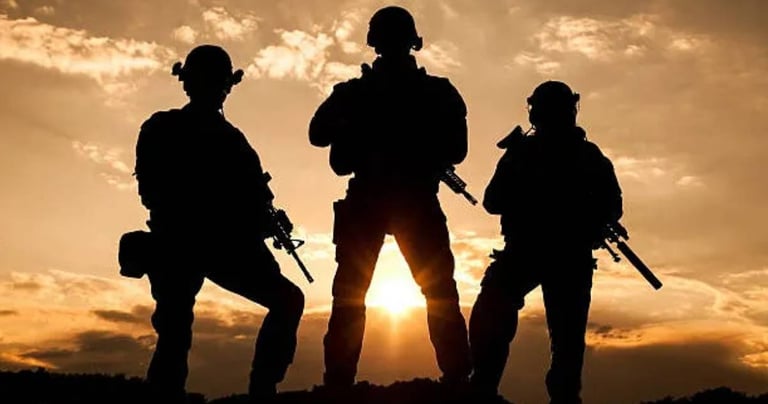11 Facts About Army
Explore 11 amazing facts about army that demonstrate discipline, bravery, and international safeguarding, learning about their resilience, mysteries, and unexpected narratives.
FACTS ABOUT


Army (credit: istockphoto)
The photos of soldiers marching in flawless line or taking on challenging assignments in distant places are frequently sparked up by the army. Exceeding the straightforward, however, armies' heritage and influence are packed with unexpected histories, inventions, and life-changing experiences. I was extremely surprised to learn how the army has influenced humanity in ways that majority of individuals are not aware of while doing this research. These 11 amazing facts about the army demonstrate how it has influenced engineering, strategy, as well as the way people act.
Army Originated in Mesopotamia: Were you aware that Mesopotamia saw the emergence of organized armies around 3000 BCE? These were the initial initiatives at organization, planning, and coordination that served as the foundation for civilization's defense mechanisms; they were more than simply bands of warriors. If you have ever had trouble managing a group project, you may see how difficult it must have appeared to manage many of individuals without the use present-day communication.
Army Was The Birthplace of Strategy: For thousands of years, the idea of army planning has been explored; Sun Tzu's The Art of War is a well-known example. Intellectuals were driven by armies to make thoughtful plans, predict the movements of their counterparts, as well as adjust to shifting circumstances. This type of strategic thinking is not just used on battlefields; it is also widely applied in business, sports, and additionally in everyday problem-solving.
Army Promoted Team Cohesion: Solidarity is essential to an army's success. To perform well under pressure, armies develop collective identification, loyalty, as well as trustworthiness. Unexpectedly, these cohesiveness principles impacted present collaboration in schools and businesses. A pressure cooker version of your office due dates, it is similar to working in a team where everybody's existence revolves around collaboration.
Army Influenced Civil Engineering: Armies had previously started building roads, bridges, as well as defensive structures when highways and bridges were considered commonplace infrastructure. In order to distribute troops and supplies successfully, various technical strategies that are today commonplace to civilians were originally implemented. The following time you cross a strong bridge, it is possible that army brilliance played a role in its design.
Army Uses Hierarchical Command: An unmistakable chain of command keeps armies disciplined. Throughout crucial missions, there is no confusion because each participant is aware of what to do and who they should report to. Envision it as a relay race with huge significance, where each baton handoff needs to be accurate or there will be disastrous results.
Army Formalized Physical Fitness: Army training is where the idea of fitness programs now originated. To guarantee soldiers could withstand the physical challenges of wars, armies developed organized training programs. A number of sports training techniques are still derived from army exercises. You may have the army to thank, or blame, if you have in the past screamed burpees while working out.
Army Popularized Camouflage: Camouflage was developed to defend armies by merging them with their surroundings; it is more than simply an aesthetic choice. Armies discovered that being invisible was frequently necessary for survival in both deserts and woodlands. Envision as a child having fun hide-and-seek and discovering that the army had made it their primary occupation.
Army Formalized Discipline Codes: In addition to keeping army members in control, demanding army regulations and conduct codes had an impact on national legislation and law enforcement. The discipline that was formerly maintained in barracks in addition to the battlefield is reflected in various aspects of present-day legal and organizational structures.
Army Advanced Engineering Techniques: Defensive structures, tactical bridges, as well as siege engines are more than just historical artifacts. They were the result of engineering brilliance that influenced civil construction, proving that practical inventiveness is frequently sparked by army need. For example, modern architects can learn regarding defense and durability from the design of a medieval castle.
Army Drove Technological Innovation: The army has remained at the epicenter of technology from GPS to gunpowder. Remarkably, the internet itself has its origins in the military's requirement for quick and secure communication. Your smartphone's apps are all somewhat thanks to army technological advances.
Army Pioneered Communication Networks: Armies created complex signaling techniques that involved flags, drums, and subsequently radio systems prior to the advent of WhatsApp and email. It took inventiveness and accuracy to coordinate troops over great distances, which is a demonstration that excellent communication is the foundation of any successful collaboration.
Summary: Legacy in Motion & Lessons Beyond The Battlefield
There is much more to the army than what is revealed in history books or movies. It has an impact on social systems, infrastructure, technology, as well as strategy. Armies have silently influenced our current environment by establishing discipline, encouraging creativity, and teaching us how to work as a team. Finding out the above facts made me realize that even the most orderly and disciplined organizations have surprising things to tell, and that what they have learned are frequently applicable to real-world situations. Therefore, keep in mind that there is more going on than just courage the following time you witness soldiers marching or learn with regard to army heritage. Each aspect of civilization is still impacted by the history of human inventiveness, resiliency, and invention.
